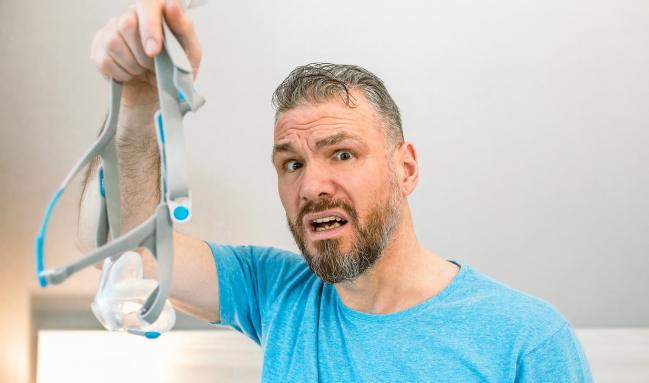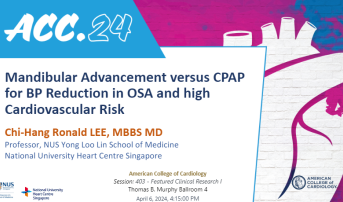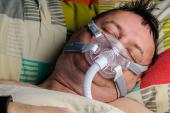Oral Device Noninferior to CPAP for Reducing BP in Sleep Apnea: CRESCENT
For patients who can’t—or won’t—use CPAP, the new findings point toward a tantalizing alternative.

ATLANTA, GA—Patients with obstructive sleep apnea (OSA) who have hypertension and are at high cardiovascular risk can obtain blood-pressure reductions similar to those seen with continuous positive airway pressure (CPAP) devices by wearing a smaller, less cumbersome oral appliance to adjust the position of their lower jaw, according to the CRESENT noninferiority trial.
“OSA is an underdiagnosed and modifiable cause of hypertension,” said Chi-Hang Lee, MBBS, MD (National University Heart Centre, Singapore), who presented the findings today at the American College of Cardiology 2024 Scientific Session. US and European hypertension guidelines, as well as scientific statements, currently recommend addressing the condition, with CPAP as the first-line treatment for maintaining airway patency during sleep, he told attendees. “However, many patients either decline to use CPAP or find it challenging to stick to the treatment.” And this has clinical impact, as reported by TCTMD, given that adherence is the key to success with CPAP.
The mandibular advancement device (MAD) strategy tested in CRESCENT has long been under study, with published data as far back as 2004. The therapy “reduces airway collapsibility by advancing the mandible during sleep,” Lee explained. It’s known to reduce sleepiness and improve quality of life, he added, and is “better accepted and tolerated.”
However, prior to CRESCENT, it was “unknown if treating OSA using MAD is effective in reducing BP due to limitations of early studies,” said Lee.
Poor Adherence to Typical OSA Treatment
For the investigator-initiated CRESCENT trial, researchers at three public hospitals used to polysomnography to screen 321 adults of Chinese ethnicity with hypertension and increased CV risk over the age of 40. Moderate-to-severe OSA (apnea-hypopnea index [AHI] ≥ 15 events/hour) was diagnosed in 220 individuals, who were randomized to receive either a custom-made, removable, and adjustable MAD (SomnoDent Flex; SomnoMed) or an autotitrating CPAP machine (AirSense; Resmed). Patients were coached by trained specialists in how to use their therapies, and the study design included a 1-month period for patients to acclimate.
During the 6-month treatment period, median duration of MAD use for patients with valid adherence data was 5.5 hours per night and 72.9% of patients used their device for at least 4 hours per night. The residual AHI was 10.8 events/hour. For CPAP, the median duration of use for patients with available data was 5.0 hours per night and 69.4% used their machine for at least 4 hours per night. The residual AHI was 2.0 events/hour.
At 6 months, 24-hour mean arterial BP had decreased in the MAD group by 2.5 mm Hg compared with baseline (P = 0.003), but the CPAP group showed no significant change (P = 0.0374). The between-group difference was -1.6 mm Hg, meeting the noninferiority margin of 1.5 mm Hg (P for noninferiority < 0.001). Other reductions in secondary ambulatory BP parameters were larger in the MAD group than in the CPAP group, most notably in measurements taken when participants were asleep.
Daytime sleepiness was reduced compared with baseline for both study groups, and there were no differences across groups in cardiovascular biomarkers.
Side effects with the MAD included dry or painful sensations in the mouth, throat or nose (27%), jaw pain (22%), tooth discomfort (17%), and hypersalivation (10%). With CPAP, the side effects included air leakage (48.5%), dryness or pain in the mouth, throat or nose (44.4%), sleep disturbances (14.1%), blocked or runny nose (14.1%), mask discomfort (11.1%), and facial rash (10.1%).
“Based upon the totality of the data, we observed there was a trend for superiority of MAD, although this study was not designed to test superiority,” the investigators conclude.
Michele Emdin, MD, PhD, Francesco Gentile, MD, and Alberto Giannoni, MD, PhD (all from Scuola Superiore Sant’Anna, Pisa, Italy), in an accompanying editorial, note that MAD therapy differs from CPAP in that it focuses on the anatomical substrate of OSA. Though there’s some existing evidence that these devices are linked to decreases in diastolic and systolic blood pressure, these decreases appear similar to what’s achieved with CPAP, they add. A 2020 meta-analysis highlighted the small size and heterogeneity that characterized prior studies looking at this question.
In CRESCENT, they say, “the different mechanisms leading to blood pressure reduction in the two arms remain elusive. Adherence was better with MAD, which perhaps offset the advantage CPAP had in terms of reducing apnea burden. “Addressing poor adherence to OSA treatments seems therefore necessary, particularly in the case of less symptomatic patients, who often have a lower perception of the related risks,” the editorialists advise, calling for a tailored approach to choosing between the two options.
Caitlin E. Cox is News Editor of TCTMD and Associate Director, Editorial Content at the Cardiovascular Research Foundation. She produces the…
Read Full BioSources
Ou Yi-H, Colpani JT, Cheong CS, et al. Mandibular advancement vs CPAP for blood pressure reduction in patients with obstructive sleep apnea. J Am Coll Cardiol. 2024;Epub ahead of print.
Emdin M, Gentile F, Giannoni A, et al. Mandibular advancement versus CPAP for obstructive sleep apnea: open your mouth wide and breathe. J Am Coll Cardiol. 2024;Epub ahead of print.
Disclosures
- This study was supported by a Clinician Scientist Award from the National Medical Research Council of Singapore) and the USyd-NUS Partnership Collaboration Award, a joint award from the National University of Singapore and the University of Sydney.
- Lee has received an honorarium from ResMed (2022) and a research grant from the Boston Scientific Corporation.
- The editorialists report no relevant conflicts of interest.






Comments